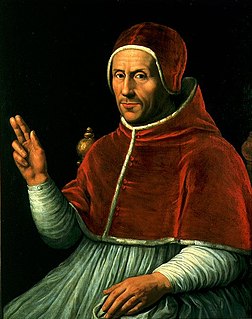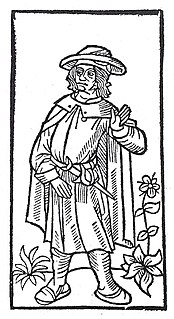
Pope Alexander VI, born Rodrigo de Borja, was Pope from 11 August 1492 until his death. He is one of the most controversial of the Renaissance popes, partly because he acknowledged fathering several children by his mistresses. Therefore his Italianized Valencian surname, Borgia, became a byword for libertinism and nepotism, which are traditionally considered as characterizing his pontificate.

Pope Adrian VI, born Adriaan Florensz Boeyens, was head of the Catholic Church and ruler of the Papal States from 9 January 1522 until his death on 14 September 1523. The only Dutchman so far to become pope, he was the last non-Italian pope until John Paul II, 455 years later.
Louis the Roman was the eldest son of Emperor Louis IV the Bavarian by his second wife, Margaret II, Countess of Hainault, and a member of the House of Wittelsbach. Louis was Duke of Bavaria as Louis VI (1347–1365) and Margrave of Brandenburg (1351–1365) as Louis II. As of 1356, he also served as Prince-elector of Brandenburg.

Louis IV, called the Bavarian, of the house of Wittelsbach, was King of the Romans from 1314, King of Italy from 1327, and Holy Roman Emperor from 1328.

Catherine of Valois was the queen consort of England from 1420 until 1422. A daughter of Charles VI of France, she married Henry V of England, and gave birth to his heir Henry VI of England. Her liaison with Owen Tudor proved the springboard of that family's fortunes, eventually leading to their grandson's elevation as Henry VII of England. Catherine's older sister Isabella was queen of England from 1396 until 1399, as the child bride of Richard II.

Catherine Parr was Queen of England and Ireland (1543–47) as the last of the six wives of King Henry VIII, and the final queen consort of the House of Tudor. She married him on 12 July 1543, and outlived him by one year. With four husbands she is the most-married English queen.

Philip the Bold was Duke of Burgundy and jure uxoris Count of Flanders, Artois and Burgundy. The fourth and youngest son of King John II of France and his wife, Bonne of Luxembourg, Philip was the founder of the Burgundian branch of the House of Valois. His vast collection of territories made him the undisputed premier peer of the kingdom of France and made his successors formidable subjects, and sometimes rivals, of the kings of France.

Charles VII, called the Victorious or the Well-Served, was King of France from 1422 to his death in 1461, the fifth from the House of Valois.

Madame Bovary is the debut novel of French writer Gustave Flaubert, published in 1856. The eponymous character lives beyond her means in order to escape the banalities and emptiness of provincial life.
A queen consort is the wife of a reigning king. A queen consort usually shares her husband's social rank and status. She holds the feminine equivalent of the king's monarchical titles, but historically, she does not share the king's political and military powers. A queen regnant is a queen in her own right with all the powers of a monarch, who (usually) has become queen by inheriting the throne upon the death of the previous monarch.

Humphrey of Lancaster, Duke of Gloucester was an English prince, soldier, and literary patron. He was "son, brother and uncle of kings", being the fourth and youngest son of Henry IV of England, the brother of Henry V, and the uncle of Henry VI. Gloucester fought in the Hundred Years' War and acted as Lord Protector of England during the minority of his nephew. A controversial figure, he has been characterised as reckless, unprincipled, and fractious, but is also noted for his intellectual activity and for being the first significant English patron of humanism, in the context of the Renaissance.

Louis I, called the Lame was Count of Clermont-en-Beauvaisis and La Marche and the first Duke of Bourbon.
The Count of Artois was the ruler over the County of Artois from the 9th century until the abolition of the countship by the French revolutionaries in 1790.

Fallen Angel is a 1945 black-and-white film noir directed by Otto Preminger, with cinematography by Joseph LaShelle, who had also worked with Preminger on Laura a year before. The film features Alice Faye, Dana Andrews, Linda Darnell, and Charles Bickford. It was the last film Faye made as a major Hollywood star, and she did not make another film until State Fair (1962).
Otto V the Bavarian, Duke of Bavaria, was a Duke of Bavaria and Elector of Brandenburg as Otto VII. Otto was the fourth son of Holy Roman Emperor Louis IV by his second wife Margaret II of Avesnes, Countess of Hainaut and Holland.
Dominic Holland is an English comedian, author and broadcaster. He won the 1993 Perrier Best Newcomer Award in Edinburgh. His BBC Radio 4 series, The Small World of Dominic Holland, won a Comic Heritage Award. Holland has also published three novels.
The Adams Chronicles is a thirteen-episode miniseries by PBS that aired in 1976 to commemorate the American Bicentennial.

Frederick VI, Margrave of Baden-Durlach was the Margrave of Baden-Durlach from 1659 until his death.

The Fairy Queen or Queen of the Fairies is a figure from Irish and British folklore, believed to rule the fairies. Based on Shakespeare's influence, in English-speaking cultures she is often named Titania or Mab.
















